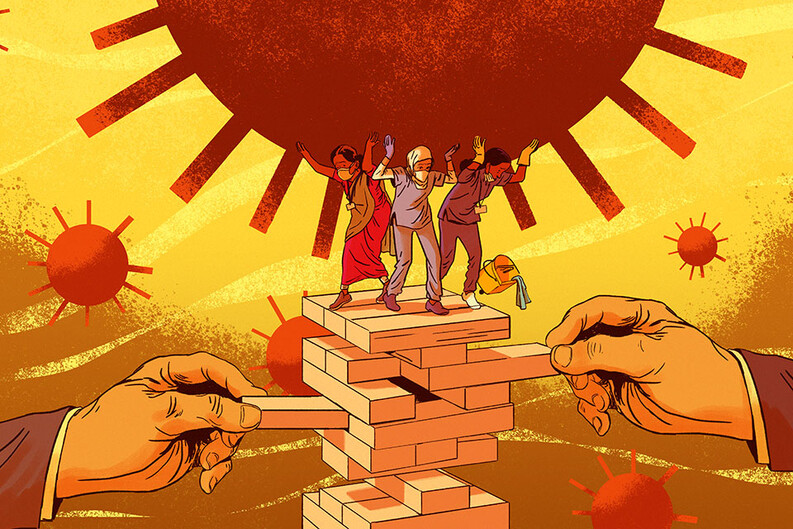Whooping Cough Outbreak Worldwide, China Reports 13 Deaths; Are We Heading For Yet Another Pandemic? How Deadly Is It And Can The Global Economy Take Another Pandemic?
Whooping cough, or pertussis, has resurfaced in several countries post-pandemic, posing a serious threat, particularly to infants and children. In China, where cases have surged dramatically, discussions on vaccination strategies are underway amidst concerns over waning immunity and rising infections. In a hypothetical scenario akin to the COVID-19 pandemic, the world would face significant challenges in dealing with another global health crisis. The current geopolitical factors further complicate the situation, with tensions and divisions among nations; therefore, the implications of another pandemic on the global economy would be profound.

Outbreaks of whooping cough have been noted in various nations, such as the UK, Australia, and Europe, with fatalities recorded in China, the Philippines, the Czech Republic, and the Netherlands.
This highly contagious infection, known scientifically as pertussis, can pose a significant risk, particularly to infants and children.
In China, whooping cough has seen a resurgence post-pandemic, with cases skyrocketing over twenty times during the initial two months of 2024.
China, the world’s second-most populous country, documented a combined total of 32,380 pertussis cases—commonly referred to as whooping cough—in January and February, compared to 1,421 cases during the same period in 2023, as reported by the National Disease Control and Prevention Administration.
The surge resulted in 13 deaths.
The tally of infections detected within the first 60 days of the year nearly matches the entire count for 2023, emphasizing the grave threat posed by this highly contagious respiratory illness in China.
The nation struggled with a significant outbreak of respiratory diseases in 2023 following its emergence from the Covid crisis in late 2022, lagging behind other countries in reopening borders and allowing the traditional circulation of pathogens.
China administers free vaccines for whooping cough, typically combined with immunization against diphtheria and tetanus in a single shot for infants, but experts note that the immunity conferred by vaccines tends to diminish as children enter adolescence.
However, Chinese health authorities neither mandate nor provide booster shots to bolster immunity.
Discussions are underway to assess whether the nation should update its vaccine or modify the immunization regimen for the disease, as suggested by Shen Hongbing, director of the Chinese Center for Disease Control and Prevention, during a conference in March.
Local media reports quote Shen emphasizing the need for vigilant measures to prevent and control the spread of whooping cough in China.
Vaccination challenges have contributed to the rise in whooping cough cases in China since 2014, surpassing 30,000 infections in 2019, according to the Chinese CDC.
After a temporary decline during the Covid pandemic, cases surged to nearly 40,000 annually in 2022 and 2023, as reported by the agency.
Various factors, including disruptions caused by Covid, waning vaccine protection, and genetic changes, may be influencing the increasing trend in whooping cough infections.
Older patients may exhibit atypical symptoms, potentially leading to misdiagnosis and enabling covert transmission of the infection.
Additionally, genetic changes in the bacteria might aid in evading detection by an immune system primed to recognize it, allowing the pathogen to persistently affect even vaccinated individuals, as reported by the Beijing Daily.
Global vaccination rates experienced a decline during the pandemic.
According to the World Health Organization and the United Nations Children’s Fund, the proportion of children receiving all three doses of the diphtheria, tetanus, and pertussis vaccine dropped to 81% in 2021, marking the lowest level since 2008.

Symptoms
The symptoms of whooping cough resemble those of a common cold, such as nasal congestion, mild fever, and a slight cough initially, making diagnosis challenging until more severe manifestations occur.
The CDC notes that symptoms can progress after a week or two to include rapid, intense coughing fits followed by a high-pitched “whoop” sound upon inhalation at the end of the fit.
Unvaccinated adults may experience coughing for up to 10 weeks.
Conversely, individuals who have been vaccinated typically exhibit milder symptoms and may not experience prolonged coughing episodes, as stated by the Netherlands’ Public Health Institute, which also highlights that over half of infants with whooping cough require hospitalization, occasionally resulting in fatalities.
Where Is A Resurgence Occurring Globally?
According to the National Disease Control and Prevention Administration, in the first two months of 2024, China recorded 13 fatalities and 32,380 cases, marking a more than twentyfold increase compared to the preceding year.
The Philippines documented 54 deaths within the first three months of this year, with infection rates soaring thirty-four times higher than the previous year.
Australia registered approximately 2,799 cases, with Queensland and New South Wales each reporting the highest count of 1,000 cases, reports The Conversation.
Meanwhile, in England’s UK, at least one infant succumbed to the disease, with February alone witnessing 913 new cases, nearly double the 555 cases documented the previous month, according to provisional data from the UK Health Security Agency.
This contrasts with 858 cases reported throughout 2023.
Since mid-2023, surges in whooping cough have been noted in European nations including Belgium, Croatia, Denmark, Spain, Sweden, and Norway, particularly significant spikes observed in the Czech Republic and the Netherlands.
Pertussis cases in the Czech Republic have reached levels not seen since the 1960s, with over 6,300 cases reported between January and the first week of April, as reported by Euronews.
By March, Spain had recorded over 8,200 cases, a notable increase compared to the 1,200 cases reported throughout 2023.
Between January and March of this year, the Netherlands reported more than 3,600 cases of whooping cough, including 228 infants, according to the NL Times, with four infant fatalities documented within the first three months of this year.
In Greece, health authorities reported 82 cases of whooping cough since the beginning of this year, a stark contrast to the nine cases recorded last year.
In the US, New York experienced an outbreak in December of the preceding year.

What Factors Are Contributing To The Rising Cases?
According to The Conversation, whooping cough outbreaks typically manifest every three to four years.
The current resurgence could be attributed to the impact of COVID-19, as stated in the report, which notes that “border closures, social isolation, and mask-wearing led to a significant decline in cases during 2020-23.”
Sylvain Brisse, director of the Institute Pasteur’s Biodiversity and Epidemiology of Bacterial Pathogens Unit, explained to Euronews Health that the pandemic-related infection control measures delayed the resurgence of whooping cough.
The disruption of routine vaccination schedules during the peak of the COVID-19 pandemic may have heightened countries’ susceptibility to the disease today.
Europe’s disease agency also linked the current surge to the pandemic, citing “lower circulation during the COVID-19 pandemic, combined with suboptimal vaccination uptake in certain groups” in a March report.
Reduced immunity in the population is another potential factor contributing to the global increase in cases, as highlighted by The Conversation.
How can we prevent the disease?
Vaccines offer protection against whooping cough, yet Sylvain Brisse noted that many countries only mandate them for children.
While vaccines provide effective protection for about five to seven years, revaccination every ten years might be ideal, but this isn’t universally practiced, Brisse explained to Euronews.
The Chinese National Disease Control and Prevention Administration issued guidance urging vaccination to prevent whooping cough and reduce its severity and mortality.
In the US, there are two vaccines available – one for children under seven and another for those older.
In the United Kingdom, babies routinely receive vaccinations, while the Philippines has raised concerns about potential shortages in vaccine supply by May.

Impact Of Yet Another Pandemic
In a hypothetical scenario akin to the COVID-19 pandemic, the world will face significant challenges in dealing with another global health crisis.
The current geopolitical arena further complicates the situation, with tensions and divisions among nations that could hinder collective efforts to combat a pandemic effectively.
Key Considerations
One key consideration is the readiness of healthcare systems worldwide. The strain experienced during the COVID-19 pandemic revealed vulnerabilities in healthcare infrastructure, including shortages of medical supplies, overwhelmed hospitals, and insufficient healthcare personnel.
Addressing these shortcomings would be crucial for managing another pandemic efficiently.
Another aspect to consider is global cooperation and coordination.
The success in combating a pandemic relies heavily on international collaboration, information sharing, and coordinated response efforts.
However, geopolitical tensions and protectionist policies witnessed in recent years could impede such cooperation, delaying crucial responses and deepening the pandemic’s impact.
Additionally, vaccine distribution and access remain critical issues.
While significant progress has been made in developing vaccines against COVID-19, ensuring equitable access to vaccines across different regions and populations remains a challenge.
Nationalistic tendencies and vaccine nationalism could hinder efforts to distribute vaccines equitably, leading to disparities in vaccination rates and prolonging the duration of the pandemic.
Furthermore, the socioeconomic impact of another pandemic would be substantial.
The disruptions caused by the COVID-19 pandemic, including lockdowns, travel restrictions, and economic downturns, highlight the far-reaching consequences of a global health crisis.

Economic Considerations
The implications of another pandemic on the global economy would be profound and multifaceted.
- Firstly, the direct economic impact would stem from disruptions to production, supply chains, and trade.
Lockdown measures, travel restrictions, and other containment efforts could lead to reduced economic activity, affecting industries such as tourism, hospitality, and retail.
Supply chain disruptions could result in shortages of goods and components, further hampering production and trade.
- Secondly, the financial markets would likely experience volatility and uncertainty.
Investor confidence would be shaken, leading to fluctuations in stock prices, currency values, and commodity markets, as seen during the COVID-19 pandemic.
Central banks and governments may need to implement monetary and fiscal measures to stabilize financial markets and support economic recovery efforts.
- Thirdly, the labor market would be severely affected, with widespread job losses and income insecurity.
Industries directly impacted by the pandemic, such as tourism and hospitality, would face significant layoffs and closures.
Additionally, remote work arrangements and digitalization could accelerate, leading to structural changes in the labor market and potentially exacerbating inequalities.
Furthermore, the pandemic’s impact on consumer behavior would reshape consumption patterns and preferences.
As seen previously, concerns about health and safety would drive changes in spending habits, with increased demand for healthcare, hygiene products, and online services.
Conversely, discretionary spending on non-essential items could decline as households prioritize essential purchases and savings.
Moreover, the global economy would face long-term structural challenges in the aftermath of another pandemic.
Issues such as debt accumulation, income inequality, and geopolitical tensions could hinder economic recovery and growth prospects.
Governments and international organizations would need to address these challenges through coordinated policy responses, investments in healthcare infrastructure, and efforts to promote inclusive and sustainable economic development.
The Last Bit, another pandemic, would have far-reaching implications for the global economy. It would repeat what the world witnessed during the Covid-19 pandemic.
While we have successfully emerged from the previous pandemic, the question is whether the world can withstand another pandemic in such a short duration, given all the factors at play—geopolitical upheaval, economic slowdown, industries and companies consolidating, limited employment opportunities, and strained healthcare.






